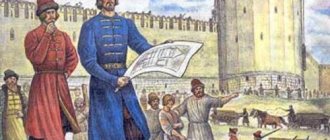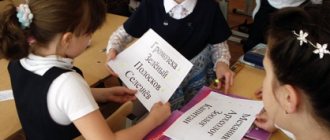Types of games on the theme “May 9”
Based on the fact that gaming activity accompanies all methods of organizing educational activities, the theme “Victory Day” is implemented in the following types of games:
- didactic (in verbal, board and printed games, games with objects);
- outdoor activities (in team and individual competitions, attention games);
- theatrical (in dramatizations, including to illustrate physical education lessons).
Games on the theme "Victory Day" usually have musical accompaniment.
Educational, that is, didactic games, are used mainly in the process of educational activities or when performing routine tasks (for example, verbal games can be played while walking), while active and theatrical games are more focused on organizing leisure activities: matinees, sports festivals.
At the same time, the goals of gaming activities in the context of the “Victory Day” theme will be common:
- gaining knowledge about the history of the country;
- development of speech, thinking and basic physical abilities;
- instilling a sense of pride in the heroism of the people during the Second World War.
These goals are specified in the context of each type of game for all age groups.
Games on the theme “Victory Day” can be held not only indoors, but also outdoors
A selection of games for younger groups
The tasks of studying the topic “May 9” in the first and second junior groups have a common direction related to the formation of a conceptual base, therefore games for children 1.5–4 years old in the methodological literature are combined into one block.
Table: didactic games on the theme “Victory Day” for younger preschoolers
| Name of the game | Attributes | Conditions |
| “Defenders of the Fatherland”/verbal | Pictures depicting military vehicles. |
|
| “One-many”/verbal | The teacher names the object in the singular, the child answers in the plural (airplane - airplanes, tank - tanks, etc.). | |
| “Who serves in the army”/verbal | Ball |
|
| “Find the shadow”/tabletop printed | Pictures depicting military equipment and shadows of vehicles. |
|
| Puzzle “Postcard for a Veteran”/desktop-printed | Postcard cut into 4–6 pieces |
|
Photo gallery: materials for the games “Defenders of the Fatherland”, “Find the Shadow” and “Postcard for a Veteran”
For children of primary preschool age, the picture for the puzzle is cut into 4 or 6 parts, depending on the general level of development of the children
The game “Find the Shadow” can be made competitive
The game "Defenders of the Fatherland" trains children's reactions
For the game “Defenders of the Fatherland” you can take up to 6 pictures
In the game "Defenders of the Fatherland" children get an idea of the grammatical structure of the language
Table: thematic active and theatrical games for younger preschoolers
| Game name/type | Attributes | Conditions |
| “Find Yourself a Pair”/individual competition | Colored handkerchiefs and tokens according to the number of children. |
|
| “Road of Life”/team competition (relay race) |
|
|
| “Knock down the pin”/individual competition |
|
|
| “Salute”/re-enactment of physical education (theatrical game) |
| |






